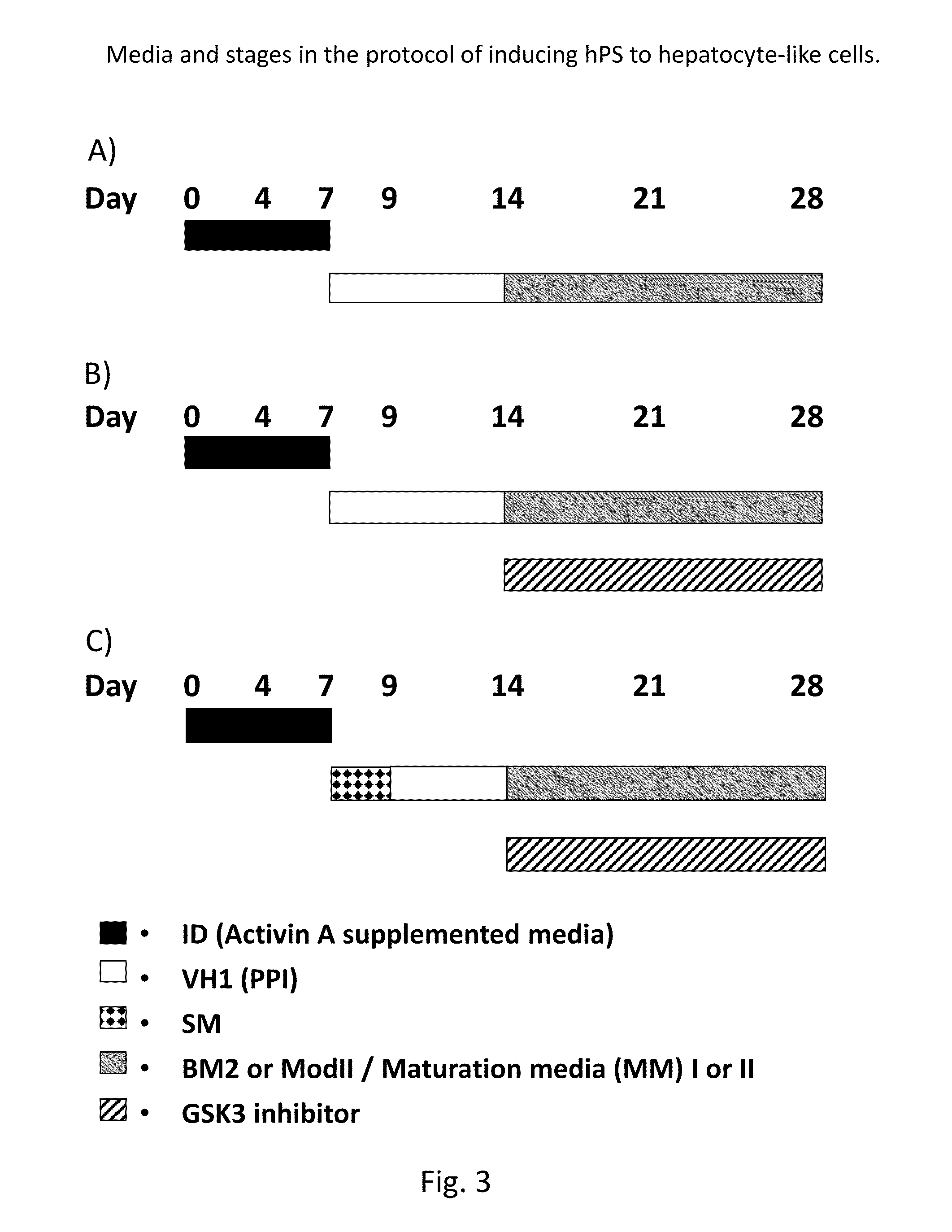Directed differentiation and maturation of pluripotent cells into hepatocyte like cells by modulation of Wnt-signalling pathway
a technology of wingless integration and signaling pathway, which is applied in the field of modulation of the wingless integration gene (wnt)signalling pathway, can solve the problems of large death rate, limited efficacy of this procedure, and major burden on the health care system, so as to improve the further differentiation and quality of hepatocyte like cells, increase the expression of hepatic markers, and improve the effect of cell type homogeneity
- Summary
- Abstract
- Description
- Claims
- Application Information
AI Technical Summary
Benefits of technology
Problems solved by technology
Method used
Image
Examples
example 1
[0151]Starting Material for Hepatocytes Derived from Human Pluripotent Stem Cells Maintained on Feeder Cells
[0152]All hPS cells (as defined above) can be used as staring material for this invention. For the examples below in particular hepatocyte-like cells were derived in vitro from undifferentiated human embryonic stem cells (hESC) cultured on mEF cells (Heins et al 2004, Stem Cells). The cell lines used for this experiment could be, but is not limited to the hES cell line SA002, SA121 and SA181 (Cellartis A B, Goteborg, Sweden) and they can be propagated as described Heins et al. 2004. These cell lines are listed in the NIH stem cell registry, the UK Stem Cell bank and the European hESC registry and are available on request. Along with hPS obtained from hESC, hPS cells invention hPS obtained from hiPS (induced pluripotent stem cells) have been used for the derivation of hepatocytes for the examples of this invention.
example 2
[0153]Derivation of hepatocytes from human pluripotent stem cells using a GSK3-inhibitor. Hepatocytes were derived from both hES cells and human hiPS cells according to the protocol in FIG. 1, this protocol gives an overview of the derivation of human hepatocyte-like cells from human pluripotent stem cells.
[0154]Before adding the first medium, ID day 0-2, the cultures were washed thoroughly with PBS, twice. The different mediums were prepared freshly and added day 0 (ID day 0-1), 2 (ID day 2-4), 4 and 7-10 every second or third day (VH1), 10-28 every second or third day (MMI or MM II). Cells are passaged at day 4 and replated at a cell density of 50 000-350 000 cells / cm2 such as e.g. 100 000-300 000 cells / cm2, preferably 200 000 cells / cm2.
[0155]The Initial Differentiation (ID) Step
[0156]Day 0-1
[0157]RPMI 1640 (+0.1% PEST, +1% Glutamax)
[0158]1×B27
[0159]100 ng / ml Activin A
[0160]1 mM NaB
[0161]Day 2-3
[0162]RPMI 1640 (+0.1% PEST+1% Glutamax)
[0163]1×B27
[0164]100 ng / ml Activin A
[0165]0.5 m...
example 3
[0186]As outlined in Example 2 and in FIG. 1, but with maturation medium II (MM II) replacing maturation medium I (MM I).
[0187]Maturation Media (MM) II
[0188]Day 10-30
[0189]WME+SQ (−GA1000)+1% Glutamax+0.1% PEST)
[0190]10 ng / ml OsM
[0191]0.1 μM DexM
[0192]20 ng / ml HGF
[0193]0.5% DMSO
[0194]+ / −1.5 μM GSK-3 inhibitor (e.g. BIO)
PUM
| Property | Measurement | Unit |
|---|---|---|
| volume | aaaaa | aaaaa |
| concentration | aaaaa | aaaaa |
| morphology | aaaaa | aaaaa |
Abstract
Description
Claims
Application Information
 Login to View More
Login to View More - R&D
- Intellectual Property
- Life Sciences
- Materials
- Tech Scout
- Unparalleled Data Quality
- Higher Quality Content
- 60% Fewer Hallucinations
Browse by: Latest US Patents, China's latest patents, Technical Efficacy Thesaurus, Application Domain, Technology Topic, Popular Technical Reports.
© 2025 PatSnap. All rights reserved.Legal|Privacy policy|Modern Slavery Act Transparency Statement|Sitemap|About US| Contact US: help@patsnap.com



